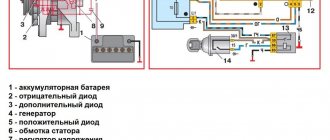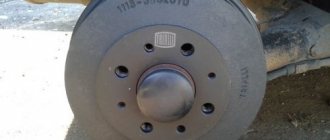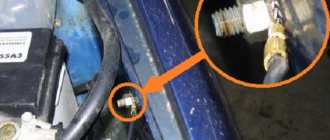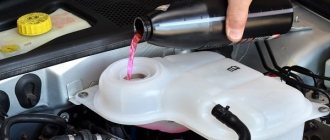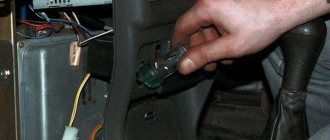The problem of constant undercharging of the battery is familiar to every city dweller. Sooner or later it results in the inability to start the engine, and this usually happens at the most inopportune moment. It is not always necessary to blame the battery itself - quite often the generator is not working properly, and battery discharge is only a consequence of this. Today we will tell you how to determine that the generator is the culprit of a dead battery, why this happens, and how it can be fixed.
Signs of a generator malfunction
Modern passenger cars are literally crammed with electronics; there are several dozen sensors alone, and over time the situation only gets worse. Automakers try to increase the power of the generator according to the needs of the on-board network, but this is not always possible, and therefore, if problems arise with the battery, it cannot be ruled out that it is simply not charged when the engine is running.
How can you understand that the generator does not charge the battery, or that it is not able to cover the loss of battery charge when starting the engine?
There are several signs indicating that the culprit of undercharging is the generator unit:
- light indication in the form of a lit battery symbol;
- insufficiently bright headlights;
- extraneous noise heard from the generator;
- interruptions in battery operation.
The combination of any two of these signs should alert you.
Note that all malfunctions associated with the operation of the unit responsible for powering the vehicle are divided into mechanical and electrical. The first include loosening of fasteners, wear of bearings and brushes, breakage of pressure springs, loosening of the drive belt tension, etc. There are also many electrical reasons - problems with wiring (breaks, short circuits), windings, burnout of the diode bridge, breakdowns, etc. .
An extreme case is a complete failure of the generator, which will simply immobilize your car. But this is not always a death sentence. In many cases the problem is fixable, although in some cases it will cost money, time and effort.
Replacing a generator is generally required only when the breakdown is quite serious, and the cost of repair, if possible, is not much cheaper than a new device.
What is battery undercharging?
An undercharged car battery is a condition when, as a result of the formation of an oxide film or insufficient charging time, the battery capacity is constantly not fully restored.
Operating the battery in this condition may further intensify the negative changes. For this reason, if signs of malfunction are detected, battery maintenance work should not be shelved.
If insufficient charge is detected, you should immediately begin to search for the reasons that led to the malfunction. It can be very difficult to determine this condition of the battery without special instruments and devices, but some signs will definitely appear, the main thing is not to miss them.
How to check the operation of the generator yourself
The generator-battery pair is the most important part of the car, without which it cannot function. Some people see the main battery in this connection, but in reality the main burden of supplying the on-board network lies with the generator, and it is its malfunctions that are responsible for the unstable operation of the electronics and undercharging of the battery.
In principle, you can check how well a generator set copes with its tasks on any sufficiently powerful consumer, but the easiest way to do this is on a battery. This will reveal the fact that the generator is not charging the battery, but to further determine the reasons, other studies and tests will be required, which we will discuss later.
The first stage of diagnostics consists of a visual inspection of the node responsible for generating electricity, and if no unusual facts are noticed, you can begin measuring voltage and current. You can check whether the generator is charging the battery with a multimeter. Twice a year you should check the tension of the drive belt, which tends to stretch. And due to the weakening of the belt, the torque is not transmitted to the generator shaft in full, and its performance decreases.
Every year you should check the quality of the fasteners, the operation of the relay regulator and the diode bridge; periodically it is necessary to carry out preventive maintenance in relation to the battery - clean the terminals, measure the level/density of the electrolyte.
Below we'll show you how to check your battery's charge using a readily available meter or load plug.
What generator for VAZ 2115
VAZ 2115 cars are equipped with three-phase alternating current generators of type 94.3701, which have a built-in rectifier unit and an electronic voltage regulator. They have the following technical characteristics:
- The motor-generator gear ratio is 1:2.4.
- The highest recoil current reaches 55 A at 5 thousand rpm. and 13 V.
- The adjustable voltage range is 14.1±0.5 V.
A special indicator light helps to monitor the operation of the device, which lights up when the ignition is turned on and goes out after it starts. But if the light remains on, this indicates a malfunction.
What kind of charging should go to the battery from the generator?
The current required for the normal operation of all electrical equipment and charging the battery is individual for each model and is calculated with a margin so that the car owner has the opportunity to connect additional equipment.
The power spread is quite high - 50-amp generators are installed in compact city cars, and 200-amp generators are installed in respectable cars and SUVs.
In any case, the relay-regulator ensures that the voltage transmitted from the generator to the battery is no more than 14 V - charging in this mode will protect the electrolyte from overheating (and in the summer it is very hot in the engine compartment - in the area around the engine at 100 degrees), at which The liquid boils, decomposing into oxygen and hydrogen.
The main problem is that the generator will charge a heavily discharged battery at a stable voltage with an increased current. For batteries that have lost most of their charge, this is fraught with big troubles, even complete failure. However, recently, expensive configurations of prestigious models have been equipped with functions that allow you to control the amount of battery charging current.
From the above, you need to understand: how many amperes the vehicle generator should supply to the battery depends on the state of charge of the battery. Under normal circumstances, this is approximately 1 A, and as the voltage in the battery increases, this value decreases to 0.5 A. Yes, this is not enough. It can be argued that generator charging of a battery is never complete, this is true. That is why it is recommended to charge once every six months using a charger.
As for the maximum current, its value is usually indicated on the generator label. If it or a component of the generator assembly is faulty, the battery will charge at reduced voltage and will be continually undercharged. Before checking the alternator voltage on the battery with a multimeter, you should make sure that other devices that consume electricity are working normally - this can narrow down further troubleshooting.
Design of a car generator
Any generator, with the exception of direct current models, creates multiphase alternating current - three or four phases, depending on the power. Why such a complication if the on-board network uses only direct current anyway? The fact is that a multiphase alternating current generator has higher efficiency, and most importantly, the current is removed not by brushes from the rotating rotor, but from the stationary stator windings. Accordingly, there are no problems with burnout of the collector (the current in it is much less than what the generator produces), and the collector itself is simpler - two rings, and not a set of insulated lamellas.
To convert polyphase alternating current into direct current, a diode bridge is used. At a minimum, it contains several powerful diodes with twice the number of phases - they are engaged in rectifying the current. Some generators also have additional diodes that provide power to the relay regulator.
The relay-regulator itself is no longer a relay: instead of an electromechanical device, electronic circuits are used to control generators, but the name “relay-regulator” has already firmly established itself behind it. They operate in the same way - by changing the current in the rotor winding (and the magnetic field in the core), they increase or decrease the voltage at the generator output so as to keep it within specified limits from 13.7 V (old low-power generators) to 14.5 V (modern generators designed for high power consumption of the on-board network and accelerated battery charging). Modern generators are no longer independent units, but are integrated with on-board controllers: the ECU controls the voltage, raising it after the engine starts to speed up battery charging, and then lowering it to normal.
Causes of undercharging of the battery by the generator and ways to eliminate them
Since the generator and the electrical circuit responsible for charging the battery consist of many components, there may be several reasons for the battery to be undercharged. Let's describe the most common of them.
Generator overload
One of the main reasons why the generator does not provide sufficient charging to the battery is that it is simply overloaded. In the standard configuration, this situation usually does not arise, but if you connect gadgets hungry for electricity (smartphone, recorder, navigator, more powerful headlights, etc.) to the on-board network, then the situation may change for the worse.
Installing a more powerful battery (for example, a 70-amp instead of a 55-60 A battery) will also lead to the fact that it will experience a constant deficit of charge current.
So, before increasing the load on the on-board network, do not be lazy, find out the power of the generator and the total current consumption of all consumers - this will protect you from rash actions.
Poor or loose contact
This problem occurs when the slip rings and brushes are heavily soiled. Weakening of the contact can also occur due to a decrease in pressure on the brushes from the weakened spring. Finally, the brushes may simply jam. All these troubles can cause an increase in excitation resistance. The problem can be eliminated by timely cleaning of contaminated elements; if there are oxides on the rings, they are removed with sandpaper.
Breaks in the winding
Another reason why the generator does not charge the battery is the presence of a break in the excitation winding. Such a malfunction is easily diagnosed - just put your hand on the case - in such cases it gets very hot. To clarify the diagnosis, the end of the winding is connected to the generator terminal instead of a brush, and then the current is measured with a multimeter through the battery. If the readings are zero, there is a break. To search for the problematic winding, battery wires are connected to each coil in turn and the measurements are repeated. If the break is external, you can try to fix it with a soldering iron. Otherwise, the entire coil is replaced.
Generator short circuit
Unlike a break, a short circuit in any section of the winding will lead to the inoperability of the entire device. Most often, a short circuit occurs at the junction of the slip rings with the winding. Test method: connect a 5-volt lamp to the rotor core and the slip ring; if there is a short circuit, the lamp will light up. The malfunction is eliminated by replacing the generator (or alternatively, replacing the winding).
If the insulation in the stator coils is partially destroyed, the generator will begin to get very hot, and the battery will be fully charged only at high speeds. The same symptoms will be observed when the stator is shorted to the device body. In such cases, the easiest way out is to replace the generator.
Mechanical breakdowns
If the battery is not charging, the reasons may be mechanical. Most often in such cases, the culprit is a loose alternator belt. This problem is easily diagnosed - when the drive belt is stretched, the pulley gets very hot. The problem is solved by replacing the belt.
You should also check the battery terminals - if they are oxidized, this is the reason for the undercharging. The reason may lie in poor contacts in the places where the wires are attached to the generator components, in their breakage, or chafing. Finally, it's worth checking to see if the fuse has blown (although it's recommended to start the diagnosis there rather than end it).
The diode bridge has failed
Since the generator generates alternating current, it needs to be converted to direct current before it is supplied to the on-board circuit. This task falls on the shoulders of the diode bridge, which acts as a rectifier. It is called a bridge because it consists of several diodes. If one of them becomes inoperative, the normal operation of the generator is disrupted. This is also a fairly common cause of undercharging of the battery due to AC leakage. A similar malfunction will be indicated by dimming of the vehicle's external and internal lighting lamps. Diagnosis of the problem is carried out by measuring the voltage and current parameters passing through the battery terminals.
The procedure algorithm is simple:
- start the power unit, let it warm up a little;
- apply the parking brake and shift the gearshift lever to neutral (or to parking mode if you have an automatic transmission);
- switch the multimeter to low amplitude AC voltage measurement mode;
- If the device shows a non-zero voltage, the diode bridge must be replaced.
Reason #1. The battery drains a lot when parked
Diagnosed as follows. Immediately after parking the car after a day's use, the density of the electrolyte is measured. Let's say it's normal and shows that the battery is 100% charged. However, the next day, similar measurements show a decrease in density. Checking the battery voltage at rest also indicates that the battery is fairly discharged.
In such cases, if the battery is good (for example, it is new), in most cases large leakage currents are to blame. To measure them, you need to switch the multimeter to ammeter mode with a measurement range of up to 10 A, and connect it to the disconnected battery terminal. That is, make sure that currents flow from one of the battery terminals to the corresponding power wire (which you disconnected).
The normal current is considered to be within 0.07 A. It may vary noticeably on different cars. But, if you show more than the specified value, this is bad. We need to look for what is consuming so much and eliminate the cause. The easiest way to do this is by removing the fuses one by one and observing the response of the ammeter.
It is strictly prohibited to start the engine while measuring leakage currents! Conventional devices are not designed for starter inrush currents, which are more than 100 A.
Now let’s assume a situation where the leakage currents are normal, but a theoretically serviceable battery (almost new or new) is still discharged in the morning. In this case, you need to check the battery itself for current leakage. To do this, you need to disconnect it from the on-board network and measure the voltage between the positive terminal and different areas on its body. There should be zeros on the device. If there is voltage between the terminal and the case, then most likely the battery is just dirty and needs to be washed thoroughly.
Dust and dirt mixed with electrolyte vapors and settled on the body are an excellent conductor of current. It shouldn't exist.
How to fix the problem
The most common reasons for a lack of charging in an electrical circuit are faulty alternator or battery. You can easily check the battery condition using a voltmeter. To do this, you need to turn off the engine. Measure the voltage at the battery terminals. For a working battery it should be 12–13 V. If the value is lower, it can be concluded that the battery is faulty. You can test the generator as follows. Start the engine and set the crankshaft speed to 2,000 rpm. Under such conditions, most of the load will fall on the generator. If the voltmeter shows a voltage drop, then the generator is faulty.
Troubleshooting
The first thing to do is check the tension of the alternator drive belt. Let's look at the main reasons why charging on a VAZ-2107 may fail. The reasons can actually be anything - even a simple broken belt. Over time, it wears out and becomes unusable. On the "sevens" the belt also drives the coolant pump. And if the belt suddenly breaks, this can be seen by the fact that the temperature of the antifreeze in the engine block will instantly increase.
If the control light in the dashboard does not light up, and the voltage in the on-board network is at a normal level, but there is still no charging, you can look for the cause of this phenomenon in the terminals and contacts that connect the wires. Remove the terminals from the battery to clean them. Very often they are covered with a layer of oxides that interfere with the conduction of current. The result is a large voltage drop. Quite often, the fault lies not even in the charging wires themselves, but in the bus that connects the body, the engine block and the negative terminal of the battery.
What charge should the battery receive?
With the voltage from the generator to the car battery, everything is approximately clear. But still, the motorist should conduct a more thorough and comprehensive performance check.
The main question is what should be the normal charging from the generator side for the battery being charged.
If a car is equipped with a battery with parameters exceeding factory recommendations, a more powerful generator will be required. Otherwise, it will not be able to provide the necessary recharging.
Now let’s talk about what kind of charge a generator should normally provide to a car battery. In order for the car to start normally, even in cold weather, the charging current from the generating device must be about 10% of the rated battery capacity. For example, if the battery has a capacity of 70 Ah, then the charging current should be 7 A.
But these are conditional characteristics, since the number of additional consumers is also taken into account. After all, the generator works not only to charge the battery, but also powers all other consumers in the car while driving and with the engine running.
